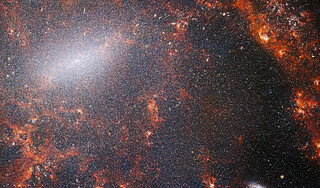Slider tool (NIRCam and MIRI images)
The bright tendrils of gas and stars of the barred spiral galaxy NGC 5068 are compared across infrared wavelengths, in these images from the NASA/ESA/CSA James Webb Space Telescope. NGC 5068 lies around 20 million light-years from Earth in the constellation Virgo. The left image was taken by Webb’s NIRCam instrument, a view that is studded by the galaxy’s massive population of stars. The right image is from the MIRI instrument, and the dusty structure of the spiral galaxy and glowing bubbles of gas containing newly-formed star clusters are particularly prominent.
With its ability to peer through the gas and dust enshrouding newborn stars, Webb is the perfect telescope to explore the processes governing star formation. Stars and planetary systems are born amongst swirling clouds of gas and dust that are opaque to observations in visible light, like many from Hubble or the VLT. The keen vision at infrared wavelengths of two of Webb’s instruments — MIRI and NIRCam — allowed astronomers to see right through the gargantuan clouds of dust in NGC 5068 and capture the processes of star formation as they happened.
MIRI was contributed by ESA and NASA, with the instrument designed and built by a consortium of nationally funded European Institutes (The MIRI European Consortium) in partnership with JPL and the University of Arizona.
Credit:ESA/Webb, NASA & CSA, J. Lee and the PHANGS-JWST Team
About the Images
| Id: | potm2305 | |
|---|---|---|
| Release date: | 2 June 2023, 11:00 | |





